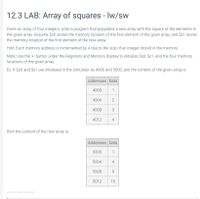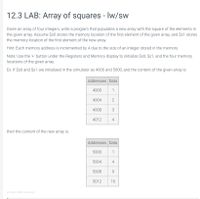
Database System Concepts
7th Edition
ISBN: 9780078022159
Author: Abraham Silberschatz Professor, Henry F. Korth, S. Sudarshan
Publisher: McGraw-Hill Education
expand_more
expand_more
format_list_bulleted
Question
Please your code should be in mips assembly language

Transcribed Image Text:**12.3 LAB: Array of squares - lw/sw**
Given an array of four integers, write a program that populates a new array with the square of the elements in the given array. Assume $s0 stores the memory location of the first element of the given array, and $s1 stores the memory location of the first element of the new array.
*Hint:* Each memory address is incremented by 4 due to the size of an integer stored in the memory.
*Note:* Use the '+' button under the Registers and Memory display to initialize $s0, $s1, and the four memory locations of the given array.
**Example:** If $s0 and $s1 are initialized in the simulator as 4000 and 5000, and the content of the given array is:
| Addresses | Data |
|-----------|------|
| 4000 | 1 |
| 4004 | 2 |
| 4008 | 3 |
| 4012 | 4 |
Then the content of the new array is:
| Addresses | Data |
|-----------|------|
| 5000 | 1 |
| 5004 | 4 |
| 5008 | 9 |
| 5012 | 16 |
This exercise illustrates how to manipulate memory addresses and data to transform an array by squaring its elements, demonstrating the basic usage of load (lw) and store (sw) instructions.

Transcribed Image Text:**12.3 LAB: Array of squares - lw/sw**
Given an array of four integers, write a program that populates a new array with the square of the elements in the given array. Assume $s0 stores the memory location of the first element of the given array, and $s1 stores the memory location of the first element of the new array.
**Hint:** Each memory address is incremented by 4 due to the size of an integer stored in the memory.
**Note:** Use the '+' button under the Registers and Memory display to initialize $s0, $s1, and the four memory locations of the given array.
**Example:** If $s0 and $s1 are initialized in the simulator as 4000 and 5000, and the content of the given array is:
| Addresses | Data |
|-----------|------|
| 4000 | 1 |
| 4004 | 2 |
| 4008 | 3 |
| 4012 | 4 |
then the content of the new array is:
| Addresses | Data |
|-----------|------|
| 5000 | 1 |
| 5004 | 4 |
| 5008 | 9 |
| 5012 | 16 |
**Explanation of Diagrams:**
- The first diagram represents the initial memory setup for the given array of integers, with each address storing one integer.
- The second diagram demonstrates how the new array looks after squaring each element from the given array, with each result stored in consecutive memory addresses.
Expert Solution
This question has been solved!
Explore an expertly crafted, step-by-step solution for a thorough understanding of key concepts.
This is a popular solution
Trending nowThis is a popular solution!
Step by stepSolved in 3 steps with 2 images

Knowledge Booster
Learn more about
Need a deep-dive on the concept behind this application? Look no further. Learn more about this topic, computer-science and related others by exploring similar questions and additional content below.Similar questions
- this is to be done in Assembly Language Please list the steps that you take the first part of this document is just some useful information to help understand what is to be done the highlighted part is what I actually need help witharrow_forwardAssembly Language: How is bitwise arithmetic completed between two numbers?arrow_forward
arrow_back_ios
arrow_forward_ios
Recommended textbooks for you
 Database System ConceptsComputer ScienceISBN:9780078022159Author:Abraham Silberschatz Professor, Henry F. Korth, S. SudarshanPublisher:McGraw-Hill Education
Database System ConceptsComputer ScienceISBN:9780078022159Author:Abraham Silberschatz Professor, Henry F. Korth, S. SudarshanPublisher:McGraw-Hill Education Starting Out with Python (4th Edition)Computer ScienceISBN:9780134444321Author:Tony GaddisPublisher:PEARSON
Starting Out with Python (4th Edition)Computer ScienceISBN:9780134444321Author:Tony GaddisPublisher:PEARSON Digital Fundamentals (11th Edition)Computer ScienceISBN:9780132737968Author:Thomas L. FloydPublisher:PEARSON
Digital Fundamentals (11th Edition)Computer ScienceISBN:9780132737968Author:Thomas L. FloydPublisher:PEARSON C How to Program (8th Edition)Computer ScienceISBN:9780133976892Author:Paul J. Deitel, Harvey DeitelPublisher:PEARSON
C How to Program (8th Edition)Computer ScienceISBN:9780133976892Author:Paul J. Deitel, Harvey DeitelPublisher:PEARSON Database Systems: Design, Implementation, & Manag...Computer ScienceISBN:9781337627900Author:Carlos Coronel, Steven MorrisPublisher:Cengage Learning
Database Systems: Design, Implementation, & Manag...Computer ScienceISBN:9781337627900Author:Carlos Coronel, Steven MorrisPublisher:Cengage Learning Programmable Logic ControllersComputer ScienceISBN:9780073373843Author:Frank D. PetruzellaPublisher:McGraw-Hill Education
Programmable Logic ControllersComputer ScienceISBN:9780073373843Author:Frank D. PetruzellaPublisher:McGraw-Hill Education

Database System Concepts
Computer Science
ISBN:9780078022159
Author:Abraham Silberschatz Professor, Henry F. Korth, S. Sudarshan
Publisher:McGraw-Hill Education

Starting Out with Python (4th Edition)
Computer Science
ISBN:9780134444321
Author:Tony Gaddis
Publisher:PEARSON

Digital Fundamentals (11th Edition)
Computer Science
ISBN:9780132737968
Author:Thomas L. Floyd
Publisher:PEARSON

C How to Program (8th Edition)
Computer Science
ISBN:9780133976892
Author:Paul J. Deitel, Harvey Deitel
Publisher:PEARSON

Database Systems: Design, Implementation, & Manag...
Computer Science
ISBN:9781337627900
Author:Carlos Coronel, Steven Morris
Publisher:Cengage Learning

Programmable Logic Controllers
Computer Science
ISBN:9780073373843
Author:Frank D. Petruzella
Publisher:McGraw-Hill Education